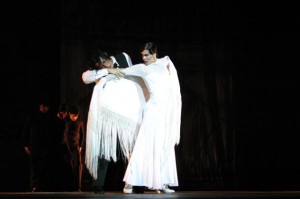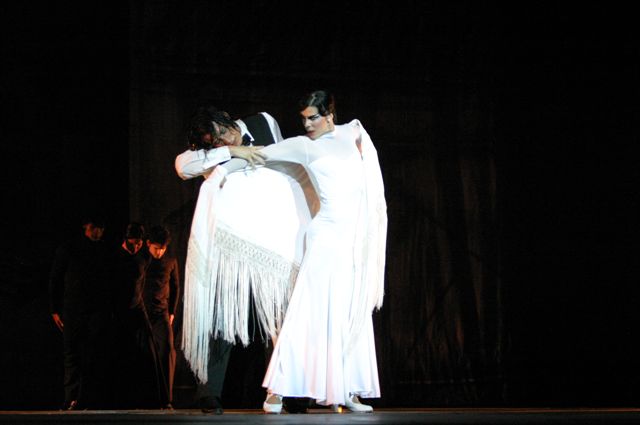 MAYRA POMBO GARCIA – Leading ballerina, maître and choreographer Irene Rodríguez has recently been awarded the First Prize in the 8th Ibero-American Choreography Competition “Alicia Alonso CIC’ 2012.” This event, convoked by the Authors’ Foundation of the General Association for Authors and Publishers (SGAE in Spanish) and the National Ballet of Cuba, awarded the talented artist for El crimen fue en Granada (The Crime was in Granada), her most recent choreographic creation. Inspired by Antonio Machado’s homonymous poem, it was premiered at the closing gala of the 24th Festival La Huella de España (Footprints of Spain).
MAYRA POMBO GARCIA – Leading ballerina, maître and choreographer Irene Rodríguez has recently been awarded the First Prize in the 8th Ibero-American Choreography Competition “Alicia Alonso CIC’ 2012.” This event, convoked by the Authors’ Foundation of the General Association for Authors and Publishers (SGAE in Spanish) and the National Ballet of Cuba, awarded the talented artist for El crimen fue en Granada (The Crime was in Granada), her most recent choreographic creation. Inspired by Antonio Machado’s homonymous poem, it was premiered at the closing gala of the 24th Festival La Huella de España (Footprints of Spain).
The jury of this contest, presided over by prima ballerina assoluta Alicia Alonso and consisting of important personalities from the international dance milieu, examined 42 works. Among competing countries were Argentina, Brazil, Chile, Cuba, Spain, Mexico and Venezuela, which made it possible to offer a wide sample of current Ibero-American choreographic work. The prestigious commission gave the First Prize to Irene “because she brought together, in an original fashion, flamenco, Spanish dance, contemporary dance and interpretation.”
With a B.A. in Theater Arts and a master’s degree in Dance, Irene is the founder and general director of the recently created company bearing her name. Barely 28 years old, she is already one of the most promising talents of Cuban Spanish dance. She has shared the stage both on the Island and overseas with figures and ensembles of the stature of Camerata Romeu, pianist Frank Fernández, the National Ballet of Cuba, the Conjunto Folklórico Nacional and with famous Spanish ballerina and choreographer Eva la Yerbabuena, among others. She was likewise the leading ballerina of Ballet Español de Cuba, directed by Eduardo Veitía, who is also the leading dancer and choreographer.
On the occasion of this well-deserved award and with the intention to learn more about this versatile artist, Cubanow obtained her statements.
How did you start dancing? What motivated you?
Ever since I was very small I was greatly inclined to artistic expressions – singing, dance, performance – until one day my mother, after much pleading by myself and my relatives and neighbors, decided to register me in the Ballet Workshops offered at the Gran Teatro de La Habana under professor Clarita. However, my passion for Spanish dance was such that I escaped from my ballet lessons and went to the hall next door where the Spanish dancing style was taught, until my mother discovered this and registered me in both classes. I thus continued developing and was even chosen by Olga Bustamante – at that time the director of the Ensemble of Spanish Dances of the Gran Teatro de La Habana, which is today the Ballet Español de Cuba – to participate in the lessons and rehearsals of that professional company, when I was only 11 years old. It was an unforgettable experience.
Those were my first steps in dance, and each moment, including when I escaped and snuck into those Spanish dance lessons, was so passionate for me that they have brought me here.
Tell us about your experiences as a teacher…
When, in 1999, I completed my studies as a ballerina, I began to teach in the Vocational Workshops of Ballet Español de Cuba and in the professional company itself, which turned me into the principal maître of the flamenco technique specialty of that company. Working with children fascinates me. They are very creative, and instead of pretending to be the teacher, you just have to let them teach you and make you understand things.
Later, in the company’s Artistic Teaching Unit, I became the head of the Department of Flamenco Technique, as well as a professor of Spanish dances, since 2006, at the National School of Ballet. Here, the objective is to improve the technical and interpretative level of those classic dance students when performing the vast Spanish repertoire belonging to the National Ballet of Cuba.
At present I am working as the Spanish dance repertoire counselor for the prestigious National Ballet of Cuba, with the responsibility of ensuring that this style is performed on stage in the most genuine way possible.
What stimulated you to create the Irene Rodríguez Company, and what projects does it have?
It is a dream I had for a long time. I think individuality results from maturity, in this case in art and creation, which appears after an arduous inner search and long experience on stage. My guidelines for work began to appear some years ago, both in my performance as a dancer/flamenco dancer and in my choreographic activity, shaping, in this way, a very personal style within Spanish dance.
That need to transmit it to the new generations, that urge to do things, to create, to form with my own totally revolutionary and transforming codes, was the main element that finally led me to found a group, the Compañía Irene Rodríguez, and thus give a new turn to my career.
In addition to being a ballerina and a professor, you work as a choreographer. What has this meant to you? What does this new responsibility represent in your career?
I have always been passionate about choreography, to express what I feel and think through movement. Even from the first classes in which I prepared my students for exams, I was already trying to make them use the entire space with great displacements, since it was much more interesting for me to train the young students in these abilities while still in the rehearsal room. These classes were like choreographies. That was how I discovered this facet, and then afterwards I have developed it, doing so in a more conscious way after I obtained my bachelor’s degree in Theater Arts at the Higher Institute of the Arts and, more recently, with a master’s degree in the Theoretical Studies of Dance.
Choreography fascinates me. It is thrilling to be able to transmit my ideas and feelings to the dancers interpreting them, and to see how they assume them and at the same time transform them according to their own interests and possibilities. I am even more excited to see how the public appropriates the choreography, decodes it and makes it their own. It is really in them that the work is to be found.
You have recently been awarded First Prize at the 8th Ibero-American Choreography Competition “Alicia Alonso CIC’ 2012” for your choreographic creation El Crimen fue en Granada, inspired by Antonio Machado’s homonymous poem. What has this prize meant to you, being so young?
It is an immense honor. Sometimes I do not consider myself worthy of so much. To receive such a prestigious international prize in the field of choreography, which in addition bears the name of our distinguished figure Alicia Alonso, is the greatest acknowledgment to the work I have carried out up to the present.
As leading ballerina I have received important national prizes such as the Choreography Prize granted by UNEAC to the best feminine dance interpretation in 2006 and the Ramiro Guerra Prize granted by the AHS (Hermanos Saíz Association) in 2011 to the best feminine interpretation in Danza Folklórica, as well as the inclusion that same year in the Book of Honor of the Gran Teatro de La Habana. However, the fact that my work has been acknowledged, this time as a choreographer, is highly important to me on this new road I intend to follow as the promoter of a professional company.
It is a great merit to receive this recognition, but also a great commitment, since it entails an artistic-choreographic level that will always have to be excelled.
What elements of the poem did you take into consideration when staging it?
I tried to capture the essence of the poem published in 1937, the dramatic form in which Antonio Machado, a great friend of the poet, narrates and makes the accusation of murder in the death of Federico García Lorca. But I also investigated Lorca’s vision of his own death, his fears and also his passion for it. That is why the poem goes: “one sees him walk alone with it, without fear of its scythe…”
It has been a beautiful experience and great team work with my recently created Company, since on the day of the premiere we were celebrating exactly five months of existence and still we obtained the most precious acknowledgment for an artist: the public’s ovation, while standing up, in García Lorca Hall. We likewise received with pleasure the recognition of specialized critics such as excellent dance critic Toni Piñera, who wrote that the company “masterly combined flamenco and contemporary dance, the gestures and particularly an almost clockwork precision in every step to express the feeling of the piece.” We also received another acknowledgment, that of his colleague Reny Martínez, who wrote the following in DANZAHOY, a specialized Washington dance magazine: “The ensemble performs with cohesion and conviction in their approach, which also drew forth numerous applauses from the audience at several climatic points […] The final ovations are a good sign for the future journey of this company.”
What is your opinion about staging this piece during the upcoming 23rd International Ballet Festival of Havana?
It is a great opportunity to be able to present this, my latest creation, during such a prestigious international event that brings together great figures of dance from around the world. I think I am receiving several prizes in one, wouldn’t you agree?
What are your dreams and projects?
Well, I have many dreams. I would write endless pages if I were to try to tell you all of them. But for the time being I am focused on creating new trends that make the Spanish genre evolve, fusing it with everything that will extend the stage language, such as dramatic arts, current contemporary dance trends, national rhythms and everything that will allow the tradition and modernity of an international genre to merge with our own very Cuban way of facing it.
Translated by Olimpia Esperanza Sigarroa Santamarina
Revised by Susana Hurlich
2012-07-10
Source: http://www.cubanow.net/pages/print.php?item=10730

